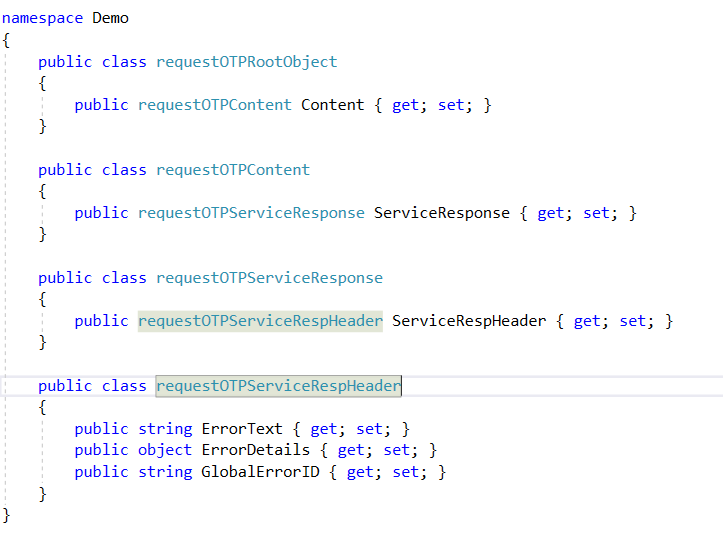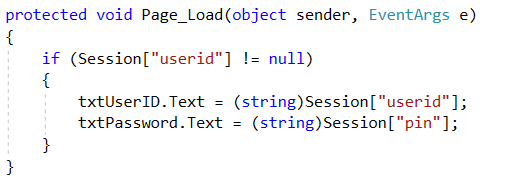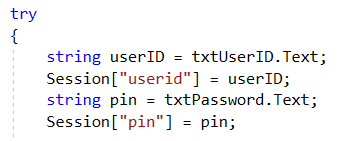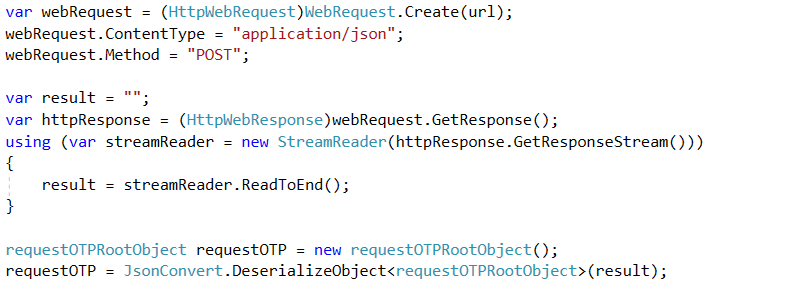Request OTP
1.requestOTP.cs
These four packages are required to be used.

Step 1. Create class file to store content of the web response.

2.requestOTP.aspx.cs
These 13 packages are required to be used.

Code in Common
(1). Check if user id and password is inside session. When the user id and password is inside user session, it will automatically populate into the user id and pin textbox, so that the user need not manually type his user id and password repeatedly.

Step 2. Store Details which entered by the user. If user id, password, and OTP exist in session, user need not enter again (refer to common stuff).

Step 3. Create URL which will be post to the server. User inputs need to be stored in the class created, and serialize into JSON format. In this function, only header is needed.

Step 4. Post to the server, and store response. URL is sent using web request function, and a response will be send back from the server. The response need to be deserialized into the ‘requestOTP’ class.
The newOTP() function can be referred to under Common Stuff Section

Step 5. Obtain error code. If error code is ‘010000’ which means invocation successful, populate attributes of the ‘requestOTP’ class into the Label. Else, we will display the ErrorText and ErrorDetails.
The newOTP() function can be referred to under Common Stuff Section

Overview of requestOTP.cs
using System;
using System.Collections.Generic;
using System.Linq;
using System.Web;
namespace Demo
{
public class requestOTPRootObject
{
public requestOTPContent Content { get; set; }
}
public class requestOTPContent
{
public requestOTPServiceResponse ServiceResponse { get; set; }
}
public class requestOTPServiceResponse
{
public requestOTPServiceRespHeader ServiceRespHeader { get; set; }
}
public class requestOTPServiceRespHeader
{
public string ErrorText { get; set; }
public object ErrorDetails { get; set; }
public string GlobalErrorID { get; set; }
}
}
Overview of requestOTP.aspx.cs
using System;
using System.Collections.Generic;
using System.Linq;
using System.Web;
using System.Web.UI;
using System.Web.UI.WebControls;
using DotNetOpenAuth.OAuth2;
using Newtonsoft.Json;
using System.Collections.Specialized;
using System.Configuration;
using System.Net;
using System.IO;
using System.Windows.Forms;
namespace Demo
{
public partial class RequestOTP : System.Web.UI.Page
{
protected void Page_Load(object sender, EventArgs e)
{
if (Session["userid"] != null)
{
txtUserID.Text = (string)Session["userid"];
txtPassword.Text = (string)Session["pin"];
}
}
protected void btnSend_Click(object sender, EventArgs e)
{
if (Page.IsValid)
{
try
{
string userID = txtUserID.Text;
Session["userid"] = userID;
string pin = txtPassword.Text;
Session["pin"] = pin;
var header = new HeaderJson();
header.userID = userID;
header.PIN = pin;
header.serviceName = "requestOTP";
header.OTP = "";
var headerJson = new HeaderJsonObject();
headerJson.Header = header;
string strHeader = JsonConvert.SerializeObject(headerJson);
string url = "http://tbankonline.com/SMUtBank_API/Gateway?Header=" + strHeader;
var webRequest = (HttpWebRequest)WebRequest.Create(url);
webRequest.ContentType = "application/json";
webRequest.Method = "POST";
var result = "";
var httpResponse = (HttpWebResponse)webRequest.GetResponse();
using (var streamReader = new StreamReader(httpResponse.GetResponseStream()))
{
result = streamReader.ReadToEnd();
}
requestOTPRootObject requestOTP = new requestOTPRootObject();
requestOTP = JsonConvert.DeserializeObject<requestOTPRootObject>(result);
string globalErrorID = requestOTP.Content.ServiceResponse.ServiceRespHeader.GlobalErrorID.ToString();
if (globalErrorID == "010000")
{
lblStatus.Text = "OTP Sent.";
}
else
{
lblTest.Text = requestOTP.Content.ServiceResponse.ServiceRespHeader.ErrorText.ToString();
string errorMessage = requestOTP.Content.ServiceResponse.ServiceRespHeader.ErrorDetails.ToString();
lblErrorMessage.Text = errorMessage;
}
}
catch (Exception ex)
{
lblExceptionMsg.Text = ex.ToString();
}
}
}
}
}
Created with the Personal Edition of HelpNDoc: Full-featured Help generator